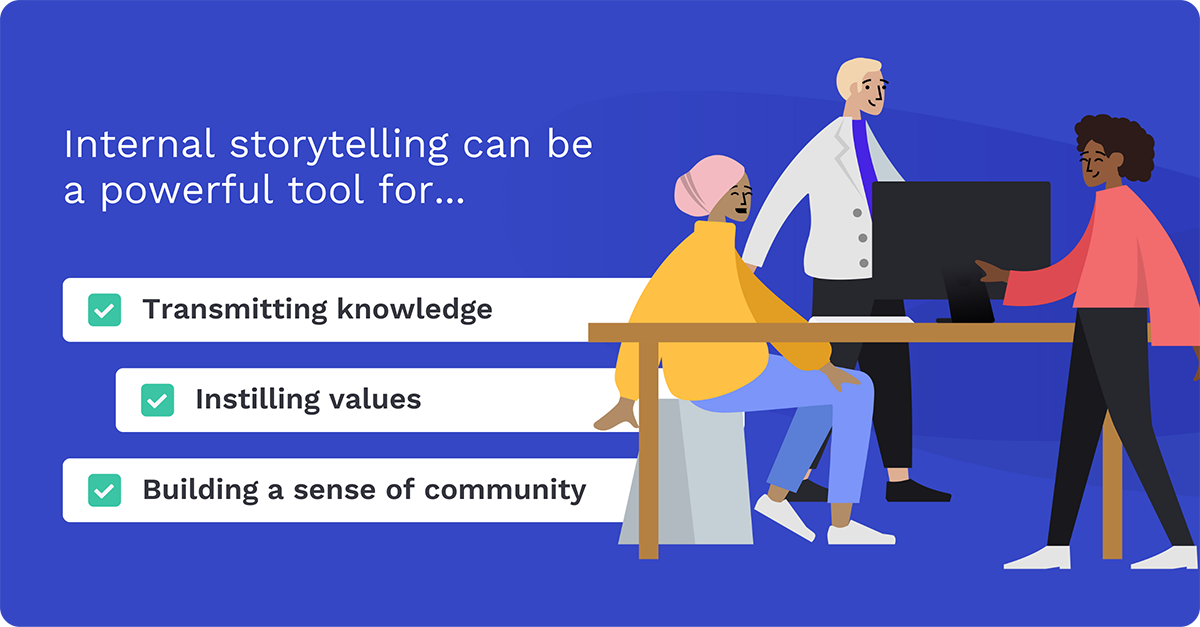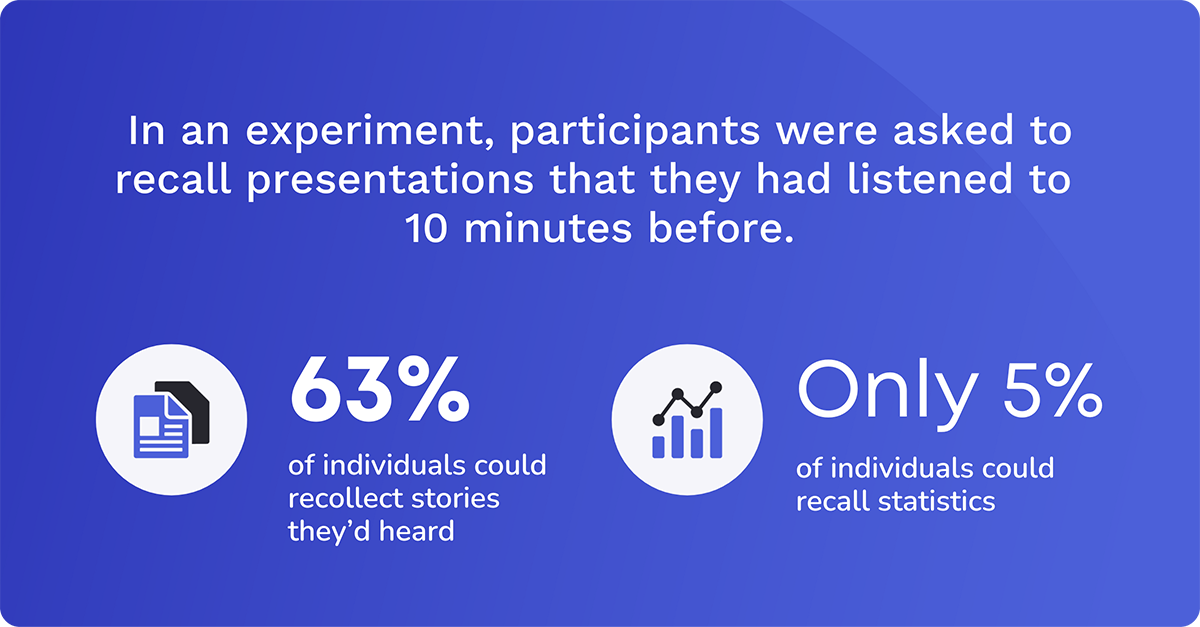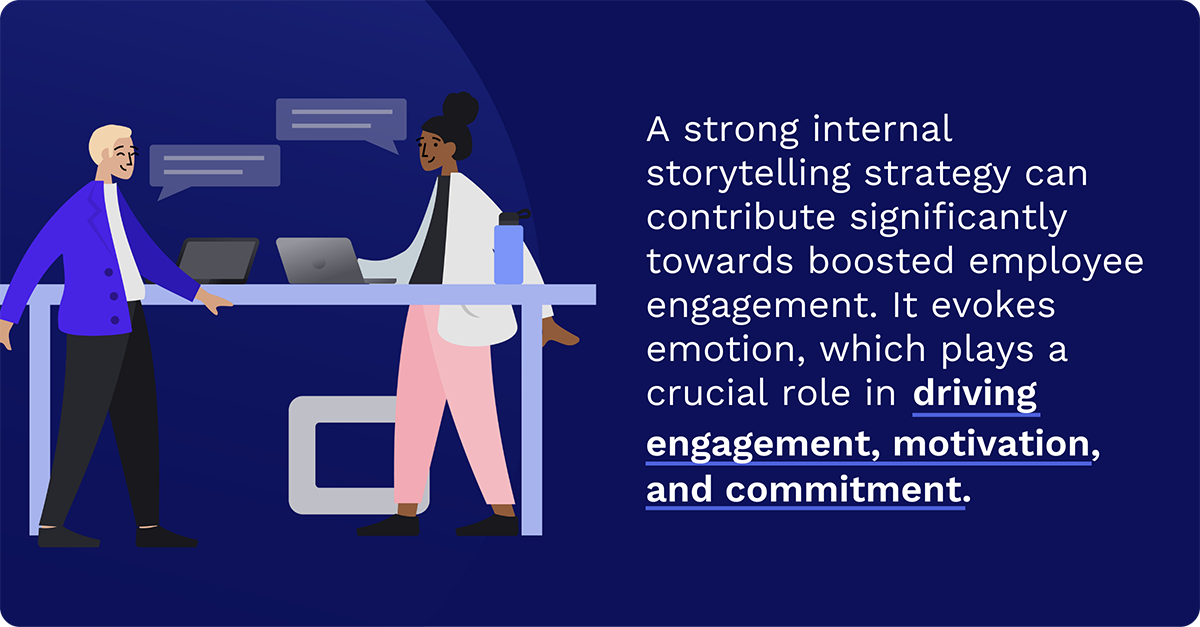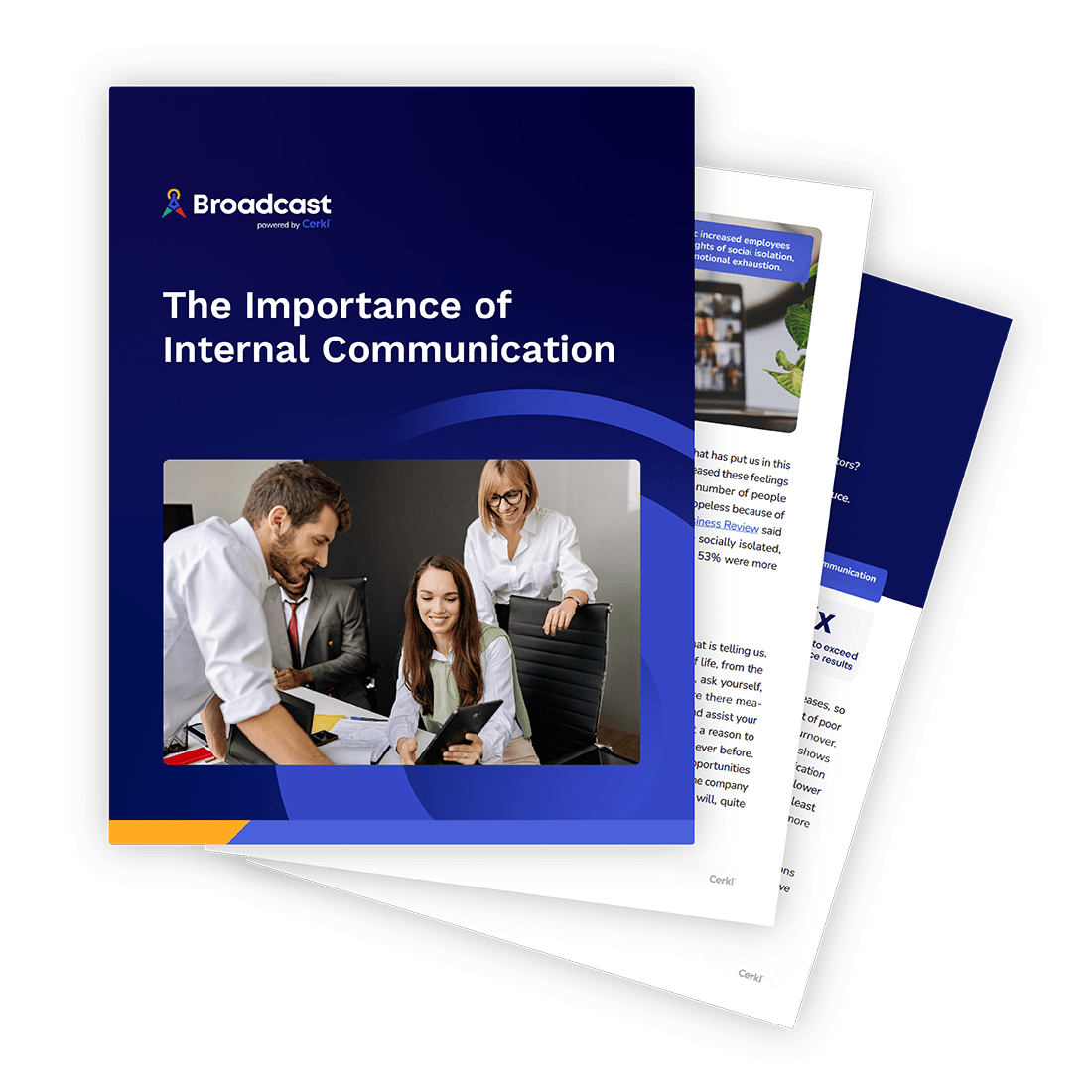 Employee Communication Best Practices
Employee Communication Best Practices
Discover the most important benefit of internal storytelling. Learn how narrative-driven communication can transform your workplace.

.webp)
Effective internal communication is the backbone of every successful organization. Learn the ins and outs of internal communications with our research-backed white paper.
Access Now
The role of internal communications in a thriving organization cannot be understated. Often, the difference between an engaged and disengaged employee lies in how effectively messages and company directives are communicated.
Storytelling has been a fundamental human skill since ancient times. However, the practice of using facts, figures, and other data to craft stories for employee engagement is a relatively recent trend.
Most of us love a good story, and by leveraging the often underestimated impact of storytelling for internal communications you can increase employee engagement and take it to the next level. As author, business coach, and leadership guru, Chris Westfall says, “storytelling beats statistics.” He gives various reasons for this claim, including the importance of context over content. It’s easy to quote numbers, he says, but this won’t change behavior. Instead, he advocates using numbers to set up your story and get others to share your vision or context.
"Leadership starts with your story. But only 100% of the time."
Chris Westfall
To make an impact using an internal story, internal communicators need to understand the principles of data storytelling. They also need to recognize the benefits of storytelling, especially the efficacy of improving internal communications and maximizing employee engagement.
We’re going to examine what falls under the umbrella of internal storytelling. We will also explore the reason it is considered by many to be a modern corporate panacea with a vast range of benefits.
Essentially, stories bring dispersed workforces and diverse geographical locations together, fostering a sense of unity among people. They can also break down silos, enabling the transfer of knowledge. By gleaning insights from historical contexts and modern applications, we aim to paint a comprehensive picture of internal storytelling and its amazing benefits.
Turn your internal communications strategy around today

Internal storytelling has its roots deeply embedded in human culture. It’s essentially the art of using language to create narratives that will evoke emotional responses and inspire action. As such, it is potentially a powerful tool for transmitting knowledge, instilling values, and building a sense of community. In the context of a company, it adheres to almost the same principles, albeit with some adjustments to suit the corporate world.

According to Gartner, 73% of organizations recognize the importance of effectively communicating IT performance and achievements. But very few know how to share and report the data effectively - and this is not limited to IT topics. In a recent series of webinars, they promoted the necessity for business leaders to incorporate storytelling as an essential component of their skillset. This makes it 100% because it’s an excellent internal communications strategy.
Internal storytelling, or corporate storytelling as it is often referred to, is a strategy often used in internal comms to effectively communicate a company’s culture, objectives, and values to its employees. This type of storytelling weaves a narrative around the purpose and objectives of a company, transforming the otherwise dull corporate vision into an engaging narrative.
Internal storytelling goes beyond the transmission of bare facts. It allows a company to share its journey, challenges, triumphs, and goals in a way that resonates with its employees, making them feel as though they're a part of something larger than themselves.

Commonly referred to as data storytelling in corporate life, it is described by Gartner as an extension of business intelligence (BI), combining narrative techniques with visualization of data.
Storytelling is historically important, dating back way before recorded history. It’s the oldest form of teaching and has a myriad of applications in today’s world. From bedtime stories that teach moral values to kids to embracing them in corporate communications, storytelling has crossed the boundaries of time and purpose.
The importance of storytelling couldn’t have been emphasized more when it became a part of political speeches and social activist movements. It has evolved into a powerful tool that may be used in workplace internal communications, which is where our focus is.
Turn your internal communications strategy around today

Understanding the power of internal storytelling can unlock a whole new level of employee engagement. When this happens, it improves not only productivity but also fosters a more wholesome work environment. Humans are biologically built to respond better to storytelling than most other types of content sharing.
In an article published in Harvard Business Review, Paul J. Zak, founding director of the Center for Neuroeconomics Studies, explains “why your brain loves good storytelling.” Based on experiments with oxytocin, a neurochemical found in the brain, he tells how effective storytelling can be whether in person or when narratives are in a video format. His research also shows that people within organizations are motivated more by transcendent rather than transactional purposes. In other words, they care more about how the company will improve lives than its success in selling goods and services. They also empathize with stories about people’s experiences.
It’s important not to forget the organization in the storytelling scenario. He emphasizes the opportunity to share the “founding myth” of your company. Examples include stories that share founders’ passions and the risks they took to start the business.
“When you want to motivate, persuade, or be remembered, start with a story of human struggle and eventual triumph. It will capture people’s hearts – by first attracting their brains.”
Paul J. Zak
Dan and Chip Heath, are brothers and authors of four New York Times bestsellers including Made to Stick, a book designed to transform the way you communicate ideas. What they advocate is turning ideas into simple stories that will inspire people to act.
One of the much-retold highlights is how they carried out an experiment on the impact of storytelling on memory retention and engagement. It was very simple. Participants were asked to recall presentations that they had listened to 10 minutes before. While 63% of them could recollect stories they’d been told, only 5% of individuals could recall statistics.

This phenomenon can be attributed to the fact that stories have the power to stimulate the release of oxytocin that Zak talks about. It makes people more inclined to connect emotionally and relate to stories rather than raw facts. Consequently, people tend to retain and remember stories more vividly compared to statistical information or raw data.
The most crucial benefit of internal storytelling is enhanced employee engagement. But there are other benefits too, including its undeniable benefits as a powerful internal communications strategy.
If you want to know what is one benefit of internal storytelling in the workplace, look no further than all-important employee engagement. A strong internal storytelling strategy can contribute significantly towards boosting employee engagement. It evokes emotion, which plays a crucial role in driving engagement, motivation, and commitment.

Like the Heath brothers, researchers from Stanford discovered that people's memory retention rates increase from 5-10% to 65-70% when provided with statistical information that includes a story or illustration. When employees are emotionally invested in their company's story, they're likely to align their personal values and goals with those of their organization.
The beauty of this connection is that it fosters a culture wherein employees begin to feel accountable for their work, thereby enhancing their productivity and overall job satisfaction. It's a compelling demonstration of how the age-old art of storytelling strengthens the modern workplace.
Internal storytelling offers more than just enhanced employee engagement. It can also play a positive role in internal conflict resolution, help to develop company values, and foster a sense of pride among employees. Stories provide a window into the company's struggles, victories, and those triumphant moments that are often masked by impersonal data and statistics.
They create a conscious object of collective pride and a sense of ownership among the staff at all levels.
Moreover, internal or corporate storytelling also helps in the onboarding process, making it easier for new hires to understand company culture, values, and mission. This comprehensive understanding helps in building loyalty toward the company.
Any good story will captivate your audience. It needs to be structured, but there are many approaches you can take. Let’s dip into a few of them.
Known as a monomyth, the Hero’s Journey was conceived by Joseph Campbell, in the mid-20th century. There are three fundamental parts: Departure, Initiation, and Return, and a series of 12 steps shown in the illustration below.

It might not be the kind of story structure you feel you should embrace for internal storytelling, but it is an epic model that applies across a myriad of mediums and genres.
In essence, you introduce the hero in the ordinary world. Your hero may be based on employee failure to achieve goals, but without focusing on one particular individual. In Part 1, you issue a call to adventure (or call to action) hoping she will meet the challenge. She or he refuses the call, which is when you introduce the mentor to your story.
In Part 2, your hero is shown to leave their comfort zone, crossing the threshold. The story continues as she makes new friends and stumbles at roadblocks. The approach is where she’s getting closer to the goal (with your guidance).
Then there’s a tough test followed by the reward at the beginning of Part 3. Now you know that there’s light at the end of the tunnel. But your hero isn’t safe yet. The resurrection is the final hurdle, and the hero then returns home with the elixir, triumphant.
In this context, it’s a story with a happy ending that is designed to inspire a new drive in the company.
Gartner research leader, Elizabeth Barrett, advocates using different types of stories depending on the objectives of specific internal communications.
The Heath brothers advocate a different strategy. This is based on a SUCCES framework they devised that says every story should be Simple, Unexpected, Concrete, Credible, Emotional, and, of course, a Story!
"When it comes to statistics, our best advice is to use them as input, not output. Use them to make up your mind on an issue. Don’t make up your mind and then go looking for the numbers to support yourself - that’s asking for temptation and trouble."
Made to Stick.
Internal and data storytelling can help to incentivize employees using effective communication. However, it’s essential that internal communicators have the skills to leverage data to its fullest potential. It’s also wise to develop a meaningful internal communications strategy.
Modern companies often incorporate internal storytelling in content marketing, internal blogs, and even videos generated by their internal communication platforms. Leaders use internal storytelling in their speeches and in all forms of their communication. This not only makes their messages more relatable but also adds a layer of trust and transparency.
The trend of converting data and statistics into storytelling formats such as infographics or animated videos is also on the rise. It encapsulates the stark reality into a form that’s easy to understand, doesn't overwhelm, and conveys impactful messages. Hence, internal communicators hold a position of significance in contemporary businesses.
Companies are also turning to internal blogging and even internal exposition storytelling to share their success stories, promote initiatives, and circulate other important information. This century-old practice of storytelling is being effectively harnessed by companies to improve their internal communication and engage their workforce more productively.
Catherine Cote, marketing coordinator at Harvard Business School Online, identifies three key components for successful data storytelling. These are data, narrative, and visualization, which can be in the form of pictures, diagrams, graphs, charts, or videos. Then you need to decide on a setting, the characters, the issue or conflict, and a resolution.
As an example, she describes how a viral social media post has negatively impacted the company. The characters will be the stakeholders responsible for the post. They don’t need to be part of the story, but she says they do need to be defined. The setting is the drop in sales, and the conflict, the root issue - the viral social media post. The resolution is your proposed solution.
This approach can be used in any form of internal storytelling and in newsletters, emails, or blog posts. Elizabeth Barrett’s approach outlined earlier, also works for all types of media.
So, now you’re wondering, what is one benefit of internal storytelling? The truth is that there are many benefits including improved employee engagement and enhanced internal communications. But there’s more to successful plans and strategies, and many channels you can explore.
Cerkl Broadcast is geared to improve your internal communication strategy and help you audit it to measure success. Our software will also free up the time and energy of internal communicators, allowing them to focus on that all-important message (story). Our resources are designed to help organizations be more strategic and effective. You create the story while we help simplify the internal communications process.
Cerkl is ready to take you to the next level of internal communications. Are you ready?

Turn your internal communications strategy around today
What is one benefit of internal storytelling? Pushed to answer the question, what is one benefit of internal storytelling, a typical answer would be increased employee engagement. Done well, it will definitely do this.
What is internal storytelling? This applies to using the craft of storytelling for internal communications. It’s an ideal way to share company values and objectives in a way that is non-threatening.
Why is storytelling important for employees? Storytelling helps to convey information in a relatable and memorable way that is easy to understand and remember. It also fosters a sense of connection and engagement among colleagues, enhancing team morale.
How does internal storytelling impact company culture? Internal storytelling creates a shared narrative that reinforces a sense of belonging and purpose within organizations. It also facilitates the transmission of core values, traditions, and lessons learned, contributing to a cohesive and culturally aligned workforce.

Turn your internal communications strategy around today